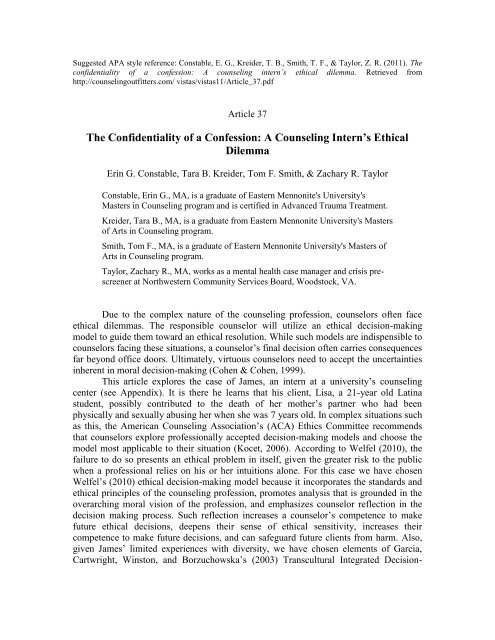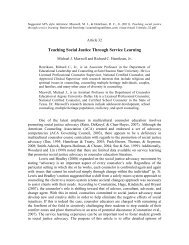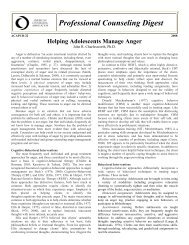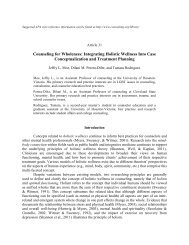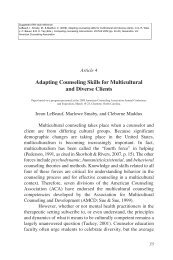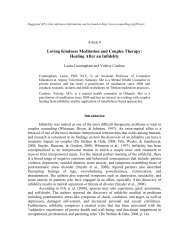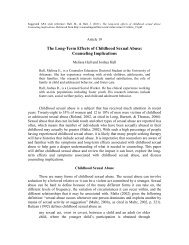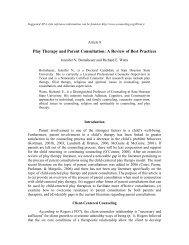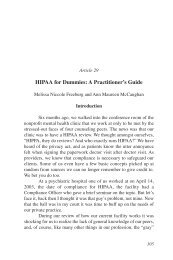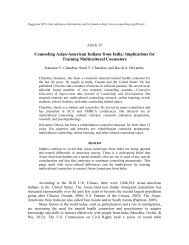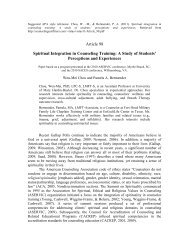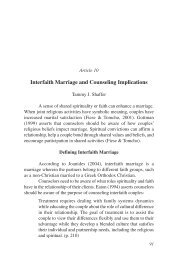The Confidentiality of a Confession - Counselingoutfitters.com
The Confidentiality of a Confession - Counselingoutfitters.com
The Confidentiality of a Confession - Counselingoutfitters.com
Create successful ePaper yourself
Turn your PDF publications into a flip-book with our unique Google optimized e-Paper software.
Suggested APA style reference: Constable, E. G., Kreider, T. B., Smith, T. F., & Taylor, Z. R. (2011). <strong>The</strong>confidentiality <strong>of</strong> a confession: A counseling intern’s ethical dilemma. Retrieved fromhttp://counselingoutfitters.<strong>com</strong>/ vistas/vistas11/Article_37.pdfArticle 37<strong>The</strong> <strong>Confidentiality</strong> <strong>of</strong> a <strong>Confession</strong>: A Counseling Intern’s EthicalDilemmaErin G. Constable, Tara B. Kreider, Tom F. Smith, & Zachary R. TaylorConstable, Erin G., MA, is a graduate <strong>of</strong> Eastern Mennonite's University'sMasters in Counseling program and is certified in Advanced Trauma Treatment.Kreider, Tara B., MA, is a graduate from Eastern Mennonite University's Masters<strong>of</strong> Arts in Counseling program.Smith, Tom F., MA, is a graduate <strong>of</strong> Eastern Mennonite University's Masters <strong>of</strong>Arts in Counseling program.Taylor, Zachary R., MA, works as a mental health case manager and crisis prescreenerat Northwestern Community Services Board, Woodstock, VA.Due to the <strong>com</strong>plex nature <strong>of</strong> the counseling pr<strong>of</strong>ession, counselors <strong>of</strong>ten faceethical dilemmas. <strong>The</strong> responsible counselor will utilize an ethical decision-makingmodel to guide them toward an ethical resolution. While such models are indispensible tocounselors facing these situations, a counselor’s final decision <strong>of</strong>ten carries consequencesfar beyond <strong>of</strong>fice doors. Ultimately, virtuous counselors need to accept the uncertaintiesinherent in moral decision-making (Cohen & Cohen, 1999).This article explores the case <strong>of</strong> James, an intern at a university’s counselingcenter (see Appendix). It is there he learns that his client, Lisa, a 21-year old Latinastudent, possibly contributed to the death <strong>of</strong> her mother’s partner who had beenphysically and sexually abusing her when she was 7 years old. In <strong>com</strong>plex situations suchas this, the American Counseling Association’s (ACA) Ethics Committee re<strong>com</strong>mendsthat counselors explore pr<strong>of</strong>essionally accepted decision-making models and choose themodel most applicable to their situation (Kocet, 2006). According to Welfel (2010), thefailure to do so presents an ethical problem in itself, given the greater risk to the publicwhen a pr<strong>of</strong>essional relies on his or her intuitions alone. For this case we have chosenWelfel’s (2010) ethical decision-making model because it incorporates the standards andethical principles <strong>of</strong> the counseling pr<strong>of</strong>ession, promotes analysis that is grounded in theoverarching moral vision <strong>of</strong> the pr<strong>of</strong>ession, and emphasizes counselor reflection in thedecision making process. Such reflection increases a counselor’s <strong>com</strong>petence to makefuture ethical decisions, deepens their sense <strong>of</strong> ethical sensitivity, increases their<strong>com</strong>petence to make future decisions, and can safeguard future clients from harm. Also,given James’ limited experiences with diversity, we have chosen elements <strong>of</strong> Garcia,Cartwright, Winston, and Borzuchowska’s (2003) Transcultural Integrated Decision-
Ideas and Research You Can Use: VISTAS 2011look at his level <strong>of</strong> racial identity development and worldview, and ask himself whatparts <strong>of</strong> his own experience, particularly his high level <strong>of</strong> privilege as a Caucasian male,might cloud his thinking and limit his awareness <strong>of</strong> and ability to empathize with Lisa’sexperience as a Latina female (Leuwerke, 2005; Richardson & Molinaro, 1996).Furthermore, James ought to examine his overall multicultural counseling <strong>com</strong>petenciesto determine which attitudes, knowledge, and skills need further attention anddevelopment (Arredondo et al., 1996; Garcia et al., 2003; Leuwerke, 2005).Consideration <strong>of</strong> how his immediate context at a university counseling center mightnarrow or expand his options may be useful as well.James also needs to evaluate the quality and quantity <strong>of</strong> information he hasregarding Lisa’s socio-cultural context and her worldview. If James concludes that heneeds more information, he must gather this information from her and/or through otheravenues without <strong>com</strong>promising her confidentiality (Welfel, 2010). Additionally, Jamesneeds to discover if Lisa has experiences with individualized or institutionalizedoppression or prejudice that might shape her relationship with him (Chung & Bemak,2002). With this in mind, James also needs to ascertain his level <strong>of</strong> rapport with Lisa andconsider what he might need to do to develop her trust (Sue & Sue, 2003).James must evaluate how <strong>com</strong>plete his understanding is <strong>of</strong> Lisa’s experience andmust identify what he has yet to learn by asking himself a series <strong>of</strong> questions. To start,how sure can James be about whether or not Lisa was indeed responsible for the death <strong>of</strong>her mother’s partner? What are the relevant legal and ethical requirements <strong>of</strong> mentalhealth pr<strong>of</strong>essionals whose clients disclose childhood abuse and possible involvement ina person’s death? How does being a counselor-in-training affect his ethical and legalresponsibilities in this case? Does the nearly 15-year distance from Lisa’s disclosureaffect James’ responsibilities? What is Lisa’s current emotional and mental state? Whatare Lisa’s wishes about the confidentiality <strong>of</strong> her disclosures? And how do Lisa’s hopesto be<strong>com</strong>e a lawyer impact James’ sensitivities? Furthermore, James needs to learn aboutLisa’s ethical thinking in regards to counseling and how might he link her values, beliefs,and assumptions to the ethical principles and standards <strong>of</strong> the counseling pr<strong>of</strong>ession(Hillerbrand & Stone, 1986). Similarly, James must consider the contextual and genderdifferences between him and Lisa that might impact the decision-making process.Additionally, James could ask, in what ways are he and Lisa similar, and how might thesefactors influence the process? For example, how could the fact that they are close in agemake a difference?Relevant StakeholdersJames must be sensitive to how the impact <strong>of</strong> his response to this situation willaffect others (Welfel, 2010). Specifically, James must consider the stakeholders involvedin his situation based on the cultural values <strong>of</strong> the client (Garcia et al., 2003). Astakeholder is defined as a person or a group <strong>of</strong> people who are connected to the clientwho may be helped or harmed by a counselor’s actions (Garcia et al., 2003; Treppa,1998). Though James and Lisa will be the primary people impacted by James’ actions,other stakeholders in this case include, but are not limited to, the university, James’supervisor(s), Lisa’s mother, and other family members she might have.3
Ideas and Research You Can Use: VISTAS 2011Step Three: Central Issues <strong>of</strong> the Dilemma and Available OptionsFrom the information gathered on all the relevant facts and stakeholders, Jamescan hone in on the fundamental issues <strong>of</strong> the ethical dilemma. Here James must ensurethat cultural information is incorporated into his considerations <strong>of</strong> the dilemma. Quickreference to the ACA codes will reveal that James must not break Lisa’s confidentialityto disclose her childhood abuse, given the absence <strong>of</strong> her abuser and no known imminentthreat <strong>of</strong> abuse in the present (ACA, 2005, Section B.2.a). <strong>The</strong>refore, the central dilemmain this case is whether or not James needs to disclose Lisa’s likely involvement in thedeath <strong>of</strong> her abuser. As James works through this dilemma, the main issue contributing tohis dilemma is the question <strong>of</strong> whether or not there are legal requirements to disclose thiskind <strong>of</strong> information. Also, given the cultural differences between James and Lisa, anotherissue contributing to the dilemma is the question <strong>of</strong> whether or not their values andassumptions about confidentiality conflict with one another’s and/or with those <strong>of</strong> thepr<strong>of</strong>ession. <strong>The</strong> concerns <strong>of</strong> this case intersect personal, pr<strong>of</strong>essional, and legal standardsthat James must consider.Next, to avoid limiting James’ possible out<strong>com</strong>es, he must think through all hisavailable options, beginning with an expansive list and leaving evaluation andelimination for later (Welfel, 2010). First, however, James must make sure that theoptions reflect Lisa’s worldview as much or more than they reflect his (Garcia et al.,2003). James’ possibilities include (a) maintaining confidentiality and telling no one,allowing Lisa to decide what she wants to do next, (b) informing only his supervisor butotherwise maintaining confidentiality, (c) calling the police to report Lisa’s suspectedinvolvement in the death <strong>of</strong> her mother’s partner, (d) encouraging Lisa to tell the policeherself what she told him, and (f) waiting for a few more sessions to see what moreinformation he might learn before proceeding. Further exploration and consultation mayreveal more alternatives for James to consider, but this initial list serves to further explorethe ethical dimensions <strong>of</strong> the dilemma and to develop some <strong>of</strong> the possible ways he couldrespond. Throughout this step, James must pay attention to his gut sense, noting whichoptions feel better than others, and which ones feel less appealing or un<strong>com</strong>fortable.James may want to consult with other trusted colleagues and with Lisa before moving onto ensure he has not overlooked vital facts or possible options (Welfel, 2010).Documentation <strong>of</strong> these considerations is also essential (Welfel, 2010).Step Four: Refer to Pr<strong>of</strong>essional Standards, Relevant Laws, and RegulationsReference to the ethical standards, relevant laws, and institutional policies andprocedures can help clarify and narrow James’ options and assist him in his work withLisa. As a counseling student, James is pr<strong>of</strong>essionally <strong>com</strong>mitted to following the set <strong>of</strong>standards and moral objectives set forth in the ACA Code <strong>of</strong> Ethics (2005) throughout thecourse <strong>of</strong> his training and career. However, in confronting the uncertainty inherent in hiscurrent and future ethical dilemmas, James would be wise to consult the pr<strong>of</strong>essionalwisdom and guidance contained in other ethical codes, such as the AmericanPsychological Association (APA) Ethical Principles <strong>of</strong> Psychologists and Code <strong>of</strong>Conduct (2002), and the American Mental Health Counselors Association (AMHCA)Code <strong>of</strong> Ethics (2000). In James’ immediate environment as a student intern at a4
Ideas and Research You Can Use: VISTAS 2011university counseling center, James must look into the protocol required, if any, requiringcounselor disclosure <strong>of</strong> a student’s potential involvement in a crime.<strong>The</strong> consulted pr<strong>of</strong>essional codes agree that James’ primary responsibility is toLisa (ACA, 2005, Standard A.1.a; AMHCA, 2000, Principle 1.A; APA, 2002, PrincipleA). This primary responsibility is built upon client-clinician trust between James andLisa. Client trust is earned by building appropriate, collaborative, and confidentialworking relationships (ACA, 2005, Standard B. Introduction). James must examine theethical codes and state laws to see if Lisa’s past actions warrant breaking confidentialityand the counselor-client trust.<strong>Confidentiality</strong>Since “trust is a cornerstone <strong>of</strong> the counseling relationship” (ACA, 2005,Standard B. Introduction) and “confidentiality belongs to the clients” (AMHCA, 2000,Principle C.3), James would need strong reasons to disclose without Lisa’s consent.According to ACA Code <strong>of</strong> Ethics (2005) counselors are required to break confidentialityonly “to protect clients or identified others from serious and foreseeable harm or whenlegal requirements demand that confidential information must be revealed” (StandardB.2.a). AMHCA’s (2000) ethics code states, “the protection <strong>of</strong> life, as in the case <strong>of</strong>suicidal or homicidal clients, exceeds the requirements <strong>of</strong> confidentiality” (Principle 3.C).James must also decide if there is a conflict between the codes and his state’slegal code. If there is a disagreement, the ACA (2005) ethics code urges James to <strong>com</strong>mitto the ethical codes and actively work to bring the conflict towards a resolution (ACA,2005, Standard H.1.b). In the Commonwealth <strong>of</strong> Virginia, mental health service providersare required to break confidentiality if there is evidence <strong>of</strong> child or vulnerable elder abuseor if the client <strong>com</strong>municates an explicit, immediate, and serious danger to self or toidentified others (Virginia Code § 54.1-2400.1). <strong>The</strong> ethics and legal codes require thatJames ascertain whether Lisa constitutes an immediate risk to herself or others.Cultural Competency<strong>The</strong> ACA (2005) and AMHCA (2000) ethics codes ask that counselors be able torespect diversity and work with a wide variety <strong>of</strong> individuals (ACA, Preamble; AMHCA,Principle 2.E). Counselors must also be able to clearly <strong>com</strong>municate to all their clients,regardless <strong>of</strong> race or culture (ACA, 2005, Standard A.2.c). <strong>The</strong> client’s confidentialityand right to privacy is in danger if the counselor is unable to <strong>com</strong>municate in a crossculturallysensitive manner (ACA, 2005, Standard B.1.a). According to the codes,counselors must ensure that they work <strong>com</strong>petently across cultures with their clients(ACA, 2005, Standard A.2.c; AMHCA, 2000, Principle 1.E.). Since the ethics codesdirect counselors to serve their clients within the boundaries <strong>of</strong> <strong>com</strong>petence, counselorswith multicultural <strong>com</strong>petency issues must learn the necessary skills and knowledgeneeded, before working with diverse clients (ACA, 2005, Standard C.2.a; AMHCA,2000, Principle 7.C).Step Five: Search the Ethics ScholarshipJames’ fifth step is to consult the pr<strong>of</strong>essional literature as it pertains to his ethicaldilemma. A review <strong>of</strong> the literature provides more specific and concrete thinking about5
Ideas and Research You Can Use: VISTAS 2011confidentiality, conflicts in the ethics codes and laws, and diversity than can possibly becovered in the ethical codes alone (Barnett & Johnson, 2008; Donner, VandeCreek,Gonsiorek, & Fisher, 2008; Jain & Roberts, 2009; Nagy, 2000; Pipes, Blevins, & Kluck,2008; Smith-Bell & Winslade, 1994). If James is familiar with the growing body <strong>of</strong>literature that pertains to his particular dilemma, he can better justify his decision tosuperiors, clients, and even legal bodies should the need arise. In James’ ethical dilemma,confidentiality and its limits take center stage. <strong>The</strong> requirements relating to whenconfidentiality should be breached has been discussed extensively in the counselingliterature. One specific source James ought to review is Fisher’s (2008a, 2008b) decisionmakingmodel(s), which is designed to specifically address dilemmas related toconfidentiality. It would also befit James to review the multicultural aspect <strong>of</strong> hissituation, for which a significant amount <strong>of</strong> literature exists as well (Constantine, Hage,Kindaichi, & Bryant, 2007; Corey, Corey, & Callanan, 2007; Johannes & Erwin, 2004;Richardson & Molinaro, 1996). Many <strong>of</strong> these cited discussions also provide extensivebibliographies from which James can further specify his research <strong>of</strong> the literature.Step Six: Apply Ethical Principles to the SituationIn this sixth step James must apply the fundamental ethical, or moral, principlesdeveloped by Kitchener (1984) to his decision-making process that support the relevantethical codes to the situation at hand. <strong>The</strong>se five ethical principles <strong>of</strong> respect forautonomy, nonmaleficence, beneficence, justice, and fidelity provide counselors aframework for examining their work with their clients. Respect for autonomy is respectfor a client’s choice, freedom, and dignity; nonmaleficence is the charge to do no harm toclients; beneficence is the responsibility to do good as a counselor; justice demands fairtreatment to the client; and fidelity is the counselor’s faithfulness to <strong>com</strong>mitments,honesty, and loyalty (Welfel, 2010).Althougth Welfel (2010) supports Kitchener’s (1984) ethical principles, a number<strong>of</strong> authors believe that virtue ethics are important as well (Cohen & Cohen, 1999; Coreyet al., 2007; Jordan & Meara, 1990; Remley & Herlihy, 2001). <strong>The</strong> difference betweenvirtue ethics and ethical principles according to Jordan and Meara (1990) is instead <strong>of</strong>focusing only on what actions to take, virtue ethics require counselors to ponder, “whoshall I be?” (p. 107). <strong>The</strong> virtue ethics are prudence, integrity, respectfulness,trustworthiness, and <strong>com</strong>passion. Prudence is a counselor’s practical wisdom; integrity isthe characteristic <strong>of</strong> honesty and consistency <strong>of</strong> character; respectfulness denotes afeeling <strong>of</strong> esteem for a client and regard for their wishes; trustworthiness is thecharacteristic <strong>of</strong> being dependable, loyal, and congruent; and <strong>com</strong>passion is sorrow overanother’s distress and the desire to alleviate their pain (Cohen & Cohen, 1999). WhenJames applies these ethical principles and virtue ethics to the current situation with Lisa,he may gain additional clarity about the ethics <strong>of</strong> each <strong>of</strong> the options he generated in StepThree.Step Seven: Consult with Supervisor and Respected ColleaguesEngaging in supervision and consultation is an important step for all counselors totake (ACA Code, 2005, Standard C.2.e) as consultation with supervisors and respected6
Ideas and Research You Can Use: VISTAS 2011colleagues provides a counselor with an objective perspective. Consultation can alsoalleviate feelings <strong>of</strong> isolation, knowing that there are others who are willing to extendtheir insight, experience, and <strong>com</strong>passion (Welfel, 2010). Since James is an intern, he isrequired to consult with his supervisor at the first chance he gets, and the information hereceives during that consultation, as long as it is ethically sound, ought to be weighedmore heavily than insight gleaned from other sources.Although Welfel (2010) includes this as step seven in her ethical decision-makingmodel, this step can be taken at any time throughout the decision-making process.Overall this step allows the counselor to summarize what insight they have gained so farin the process. It also allows them to process through their choices and receive feedbackon what the most ethical choice is. If James does not feel as though his supervisor and/orother colleagues provided enough assistance, particularly regarding the multiculturalelements <strong>of</strong> this case, he can also contact the ACA Ethics Committee, state licensingboard, and/or state pr<strong>of</strong>essional agency (Welfel 2010).Step Eight: Deliberate and DecideAfter carefully working through Welfel’s (2010) model, the counselor sortsthrough all gathered information in order to make a decision, and prepares forimplementation. <strong>The</strong> counselor needs to consider virtue ethics, moral principles, as wellas personal values that will affect the decision-making process (Cohen & Cohen, 1999).This step, which may be a difficult one at times, is an important step because it connectsall <strong>of</strong> the pieces together. James will need to work through this step by himself,recognizing his moral responsibility to the pr<strong>of</strong>ession and to his client is <strong>of</strong> utmostimportance (Welfel, 2010). It is critical for James to <strong>com</strong>e to a decision that he is satisfiedwith as a pr<strong>of</strong>essional and will be able to defend to his peers and superiors if everrequired to do so, knowing that he carries the full weight <strong>of</strong> the responsibility for hischoice.Re<strong>com</strong>mendationAfter working through the ethical decision making model, we conclude that Jameshas no good reason to break Lisa’s right to confidentiality in this case. After a review <strong>of</strong>the pr<strong>of</strong>essional standards and codes, James would only be required to breakconfidentiality when there is “serious and foreseeable harm” (ACA, 2005, StandardB.2.a) or when legal requirements demand it. This code also does not conflict with anyVirginia laws. <strong>The</strong> ethical scholarship also gives no indication that reports <strong>of</strong> past abuseor unsubstantiated memories <strong>of</strong> a minor’s involvement in someone’s death are groundsfor breaking a client’s confidentiality. We do re<strong>com</strong>mend that James engage in an indepthdiscussion <strong>of</strong> Lisa’s reports to ensure he, in fact, has all the relevant informationand to be always listening for more substantial information that might indicate Lisa poses“serious and foreseeable harm” (ACA 2005, Standard, B.2.a) to herself or others. We alsore<strong>com</strong>mend that James seriously examine his multicultural <strong>com</strong>petencies as he engages inthis discussion with Lisa, taking special note <strong>of</strong> any cultural variables that might hinderthe implementation <strong>of</strong> his final decision (Garcia et al., 2003). Finally, we encourageJames to continue to develop his ability and sensitivity toward clients <strong>of</strong> diverse culturesthroughout his training and in the future.7
Ideas and Research You Can Use: VISTAS 2011Step Nine: Inform Supervisor, Implement and Document ActionsOnce James arrives at his decision, he then moves into step nine which requireshim to implement and document the decision, as well as inform his supervisor and client<strong>of</strong> his decision. This step requires James to have “ethical courage” (Welfel, 2010, p. 53)to follow through with his decision, even when faced with resistance. In order to build upthe necessary courage, James may choose to discuss with colleagues and/or review therelevant literature and codes again before implementation. Upon <strong>com</strong>pletion <strong>of</strong> therequired tasks James will then need to document his decision, how it was implemented,the conversations that he had with his client and supervisor, and his rationale for doing all<strong>of</strong> this in appropriate files and case notes should he later be challenged about the case(Welfel, 2010).Step Ten: Reflect on the ExperienceOnce the dust has settled, it’s important for a counselor to reflect upon theirdecision. Reflection allows a counselor to see where they would have handled thesituation differently, which is helpful for the next time they are faced with a similarsituation. Most importantly it increases ethical sensitivity for the next time an ethicaldilemma occurs (Welfel, 2010).Through this last step <strong>of</strong> Welfel’s (2010) model, James will be able to see who hehas be<strong>com</strong>e. Working through this ethical dilemma has been a difficult, but rewarding,process. James is now in a position to think more clearly about ethics and ethicaldilemmas in the future, which will strengthen his own practice and the credibility <strong>of</strong> thecounseling pr<strong>of</strong>ession as a whole. At this stage he will want to ask himself a series <strong>of</strong>questions: How were his feelings changed or challenged by the situation? How will thisprocess affect him and his clients in the future? Does he need to learn more about ethics?Is there anything that he would improve on or have done differently? <strong>The</strong> answers tothese questions and this overall reflection process will be crucial to James’ continuedjourney as a counselor (Welfel, 2010).ReferencesAmerican Counseling Association. (2005). ACA Code <strong>of</strong> Ethics. Alexandria, VA: Author.American Mental Health Counselors Association. (2000). Code <strong>of</strong> ethics <strong>of</strong> the AmericanMental Health Counselors Association. Alexandria, VA: Author.American Psychological Association. (2002). Ethical principles <strong>of</strong> psychologists andcode <strong>of</strong> conduct. American Psychologist, 57, 1060-1073.Arredondo, P. M., Toporek, M. S., Brown, S., Jones, J., Locke, D. C., Sanchez, J., &Stadler, H. (1996). Operationalization <strong>of</strong> the multicultural counseling<strong>com</strong>petencies. Alexandria, VA: Association <strong>of</strong> Multicultural Counseling andDevelopment.Barnett, J., & Johnson, W. (2008). Mandatory reporting requirements: Ethics deskreference for psychologists (pp. 193-195). Washington, DC: AmericanPsychological Association.8
Ideas and Research You Can Use: VISTAS 2011Chung, R. C, & Bemak, F. (2002). <strong>The</strong> relationship <strong>of</strong> culture and empathy in crossculturalcounseling. Journal <strong>of</strong> Counseling and Development, 80, 154–159.Cohen, E. D., & Cohen, G. S. (1999). <strong>The</strong> virtuous therapist: Ethical practice <strong>of</strong>counseling & psychotherapy. Belmont, CA: Wadsworth Publishing Co.Constantine, M. G., Hage, S. M., Kindaichi, M. M., & Bryant, R. M. (2007). Socialjustice and multicultural issues: Implications for the practice and training <strong>of</strong>counselors and counseling psychologists. Journal <strong>of</strong> Counseling andDevelopment, 85(1), 24-28.Corey, G., Corey, M. S., & Callanan, P. (2007). Issues and ethics in the helpingpr<strong>of</strong>essions (7th ed.). Monterey, CA: Brooks/Cole Publishing Co.Donner, M., VandeCreek, L., Gonsiorek, J., & Fisher, C. (2008). Balancingconfidentiality: Protecting privacy and protecting the public. Pr<strong>of</strong>essionalPsychology: Research and Practice, 39(3), 369-376.Fleck-Henderson, A. (1995). Ethical sensitivity: A theoretical and empirical study.Dissertation Abstracts International, 56, 2862B.Fisher, M. (2008a). Protecting confidentiality rights: <strong>The</strong> need for an ethical practicemodel. American Psychologist, 63(1), 1-13.Fisher, M. (2008b). Clarifying confidentiality with the ethical practice model. AmericanPsychologist, 63(7), 624-625.Garcia, J., Cartwright, B., Winston, S., & Borzuchowska, B. (2003). A transculturalintegrative model for ethical decision-making in counseling. Journal <strong>of</strong>Counseling & Development, 81(3), 268.Hillerbrand, E., & Stone, G. L. (1986). Ethics and clients: A challenging mixture forcounselors. Journal <strong>of</strong> Counseling and Development, 64, 419-420.Jain, S., & Roberts, L. (2009). Ethics in psychotherapy: A focus on pr<strong>of</strong>essionalboundaries and confidentiality practices. Psychiatric Clinics <strong>of</strong> North America,32(2), 299-314.Johannes, C. K., & Erwin, P. G. (2004). Developing multicultural <strong>com</strong>petence:Perspectives on theory and practice. Counseling Psychology Quarterly, 17(3),329–338.Jordan, A. E., & Meara, N. M. (1990). Ethics and the pr<strong>of</strong>essional practice <strong>of</strong>psychologists: <strong>The</strong> role <strong>of</strong> virtues and principles. Pr<strong>of</strong>essional Psychology:Research and Practice, 21, 107-114.Kitchener, K. S. (1984). Intuition, critical evaluation and ethical principles: <strong>The</strong>foundation for ethical decisions in counseling psychology. <strong>The</strong> CounselingPsychologist, 12, 43-55.Kocet, M. M. (2006). Ethical challenges in a <strong>com</strong>plex world: Highlights <strong>of</strong> the 2005ACA code. Journal <strong>of</strong> Counseling and Development, 84, 228-234.Leuwerke, W. (2005). Training, growth, and development for white counselors.Guidance and Counseling, 21(1), 21-29.Nagy, T. (2000). Privacy and confidentiality. Ethics in plain English: An illustrativecasebook for psychologists. Washington, DC: American PsychologicalAssociation.Neukrug, E., Milliken, T., & Walden, S. (2001). Ethical <strong>com</strong>plaints made againstcredentialed counselors: An updated survey <strong>of</strong> state licensing boards. CounselorEducation and Supervision, 41(1), 57-70.9
Ideas and Research You Can Use: VISTAS 2011Pipes, R., Blevins, T., & Kluck, A. (2008). <strong>Confidentiality</strong>, ethics, and informed consent.American Psychologist, 63(7), 623-624.Remley, T. P., & Herlihy, B. (2001). Ethical, legal, and pr<strong>of</strong>essional issues incounseling. Upper Saddle River, NJ: Merrill Prentice Hall.Richardson, T. Q., & Molinaro, K. L. (1996). White counsellor self-awareness: Aprerequisite for developing multicultural <strong>com</strong>petence. Journal <strong>of</strong> Counselling andDevelopment, 74, 238-242.Smith-Bell, M., & Winslade, W. (1994). Privacy, confidentiality, and privilege inpsychotherapeutic relationships. American Journal <strong>of</strong> Orthopsychiatry, 64(2),180-193.Sue, D. W., & Sue, D. (2003). Counseling the culturally diverse. <strong>The</strong>ory and practice(4th ed.). New York, NY: John Wiley.Treppa, J. A. (1998). A practitioner's guide to ethical decision-making. In Robert M.Anderson Jr., Terri L. Needels, Harold V. Hall (Eds.), Avoiding ethicalmisconduct in psychology specialty areas (pp. 26-41). Springfield, IL: Charles C.Thomas.Welfel, E. R. (2010). Ethics in counseling and psychotherapy: Standards, research andemerging issues (4th ed.). Pacific Grove, CA: Brooks/Cole.Note: This paper is part <strong>of</strong> the annual VISTAS project sponsored by the American Counseling Association.Find more information on the project at: http://counselingoutfitters.<strong>com</strong>/vistas/VISTAS_Home.htm10
Ideas and Research You Can Use: VISTAS 2011AppendixCase Scenario for Masters Level StudentsACA 2009 Graduate Student Ethics CompetitionJames is a <strong>com</strong>munity counseling student who is interning with the College CounselingCenter at the local university. James is a 25 year-old Caucasian male, who attended aprivate high school in the suburbs. He admits that one <strong>of</strong> his challenges is that he has notexperienced much diversity in his relationships. He recently began working with Lisa, a21 year-old Latina female who presented with symptoms associated with depressionincluding decreased motivation, loss <strong>of</strong> appetite and overall dissatisfaction. James hasmet with Lisa three times, with the first two times being focused on her recent break-upwith her boyfriend and the resulting academic difficulties. She was very concerned thather career dream <strong>of</strong> be<strong>com</strong>ing a lawyer may be in jeopardy.In their previous session, Lisa casually mentioned that she began to experiencedepressive symptoms as a child when her mother's partner began to physically abuse herat the age <strong>of</strong> 5½ years. Lisa told her mother about the abuse, but she did not intervene.Shortly after the physical abuse began, the man began to also sexually abuse her. Onceagain, Lisa reported this to her mother and also to a teacher at her school, but nothing wasever done. Lisa reported that when she was 7, she placed an unknown prescriptionmedication <strong>of</strong> her mother's into this man's alcoholic drink. Later that same day, the manexperienced a stroke and was rushed to the hospital where he later died. Lisa alsoreported learning that her mother's partner's stroke and subsequent death were related tothe <strong>com</strong>bination <strong>of</strong> prescription medication and alcohol. <strong>The</strong> client has never told anyoneother than James that she had placed medication in this man's drink.What are the ethical/legal implications associated with working with this client? Whatshould the counselor-in-training do?11


